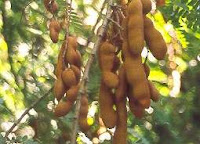Leguminosae
Description:
Tamarind (Tamarindus indica) is a cultivar of tropical and include plants fruiting peas. The trunk hard enough to grow into a big and shady leaves. Long-stemmed leaves tamarind, about 17 cm and finned even. The flowers are yellow and fruit reddish brown pods with a distinctive sour taste. In addition there is the fruit peas of skin
that encloses the fruit flesh, there are also seeds amounted to 2-5 in the form of flat to slightly blackish brown color.
Chemical Content:
Fruit tamarind peas contain chemical compounds such as Appel acid, citric acid, sour grapes, tartaric acid, succinic acid, pectin and sugar invert. Tamarind fruit that ripen on the tree of them contain the caloric value of 239 cal per 100 grams, 2.8 grams protein per 100 grams, 0.6 grams of fat per 100 grams, 62.5 grams of carbohydrate per 100 grams, calcium 74 milligrams per 100 grams, 113 milligrams of phosphorus per 100 grams, 0.6 milligrams of iron per 100 grams, vitamin A 30 SI per 100 grams, vitamin B1 0.34 milligrams per 100 grams, 2 milligrams of vitamin C per 100 grams. Seed coat and seeds contain phlobatannnin contain albuminoid and starch.
The disease Curable:
Asthma, cough, fever, heat pain, rheumatic, abdominal pain, morbili; Allergies, Thrush, new wounds, sores ulcers, eczema, boils, swelling stung by centipedes / bees, venomous snake bites, hair loss.

No comments:
Post a Comment